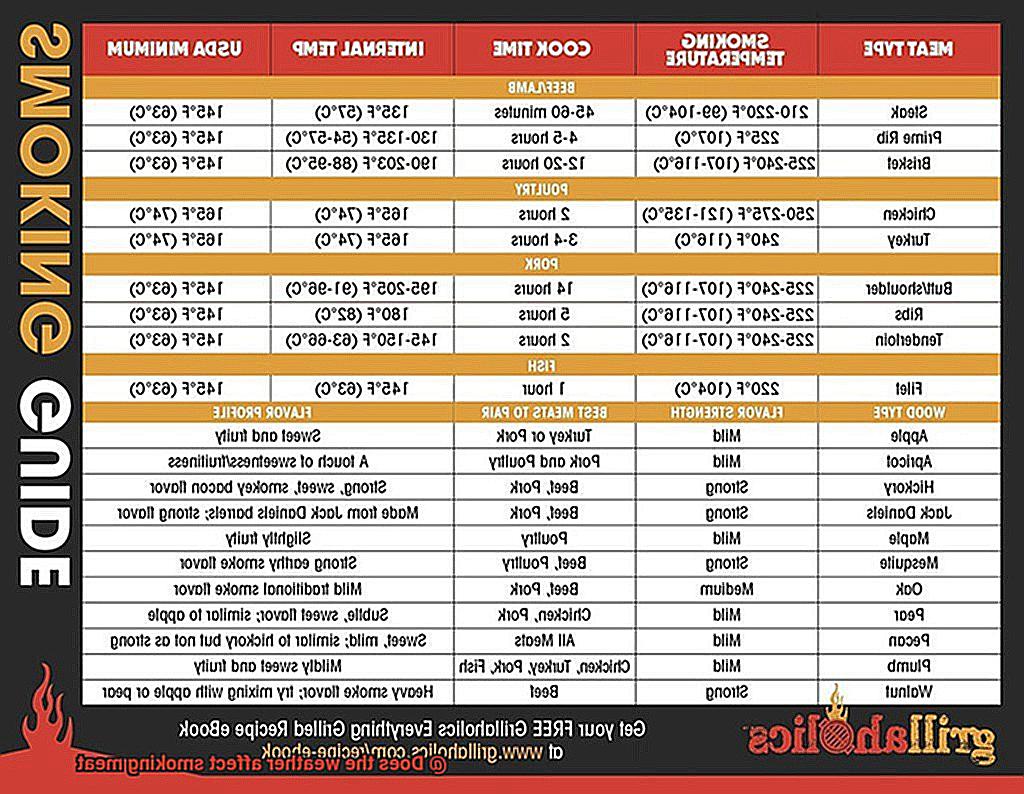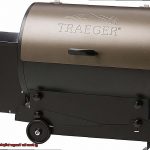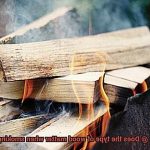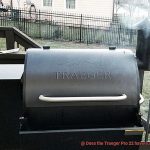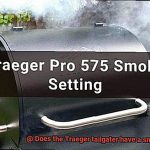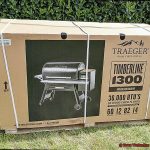Smoking meat isn’t just about tossing it on the grill and hoping for the best. It’s a culinary adventure that demands attention to detail, especially when it comes to the weather. Yep, you heard that right – the weather can make or break your smoked masterpiece. In this blog post, we’re diving headfirst into the smoky world of how weather conditions affect smoking meat. Get ready to uncover the secrets behind achieving mouthwatering flavors and tender bites, rain or shine.
Contents
Does the weather affect smoking meat?
Understanding the impact:
Temperature, humidity, and wind – these three musketeers have a direct say in how your smoking game plays out. Picture this: low temperatures creating a slow-cooking paradise where flavors mingle like old friends at a backyard party. But hold up. On scorching summer days, battling high ambient heat can turn your dreamy smoke session into a sweaty nightmare.
Humidity is another sneaky player in this game. High humidity slows down evaporation, making it harder for that delicious bark to form on your meat. Dry conditions, on the other hand, speed things up but might leave you with a Sahara-like final product. Balancing humidity is key to unlocking flavor nirvana.
And let’s not forget about wind – that mischievous troublemaker. Strong gusts can mess with your smoke flow and even blow out your fire (cue sad trombone). Plus, they can create hot spots inside your smoker, leading to uneven cooking that’ll make you want to tear your hair out. Finding a cozy spot away from those pesky winds is crucial for BBQ success.
Potential challenges and benefits:
Now, I won’t lie – weather conditions can throw some curveballs at you during smoking sessions. But guess what? They also bring unexpected perks. Cold climates mean longer cook times which give your meat ample opportunity to soak up all those smoky flavors. On the flip side, warmer weather can speed things up, getting that deliciousness on your plate faster than you can say “pass me a napkin.”
And then there’s low humidity – the secret weapon for creating a drool-worthy crust or bark. Picture sinking your teeth into a beautifully caramelized exterior that gives way to juicy tenderness. It’s as good as it sounds.
What is Smoking Meat?
Smoking meat is not just a cooking technique; it’s a culinary adventure that has been passed down through generations. From ancient preservation methods to modern regional traditions, smoking adds a unique flavor and aroma to meats while preserving their tenderness.
In this article, we will explore the process of smoking meat, its historical significance, the different types of smokers, the mouthwatering meats commonly smoked, and the regional smoking traditions that have made barbecue a beloved culinary heritage.
What is Smoking Meat?
Smoking meat involves exposing it to smoke from burning wood or charcoal. This slow and low-temperature cooking method tenderizes the meat and infuses it with a delicious smoky essence. It originated as a preservation technique before refrigeration was available, eventually evolving into a culinary art appreciated for its flavor-enhancing properties.
Types of Smokers
There are various types of smokers to suit every griller’s preference. Offset smokers, with their firebox located next to the cooking chamber, allow for direct heat and smoke control. Vertical water smokers use water as a heat sink to maintain a consistent temperature.
Electric smokers offer convenience with precise temperature regulation. Pellet smokers use wood pellets for both heat and smoke production.
Kamado grills, with their ceramic construction, excel at retaining heat. Whether you’re a traditionalist or a tech-savvy grilling enthusiast, there’s a smoker for you.
Benefits of Smoking Meat
Besides enhancing flavor, smoking meat offers several additional benefits. It acts as a natural preservative by inhibiting the growth of bacteria while tenderizing tough cuts through slow cooking. Moreover, the smoky flavor derived from this method cannot be replicated by other cooking techniques.
Commonly Smoked Meats
From succulent beef briskets to mouthwatering pork ribs and flavorful smoked chicken, almost any meat can be smoked to perfection. Different cuts require varying smoking times and temperatures, resulting in tender and juicy dishes that will impress even the most discerning palate.
Regional Smoking Traditions
Smoking techniques and flavor profiles vary across regions. American barbecue boasts its low and slow smoking style, with Texas-style, Kansas City-style, and Carolina-style variations. These regional traditions bring their own rubs, sauces, and wood preferences to create distinct flavors that have made barbecue a beloved culinary heritage.
How Does Weather Affect Smoking Meat?
Weather conditions can have a profound impact on the art of smoking meat, taking your grilling game to a whole new level. Let’s dive into the smoky world of meat and explore how different elements of weather can affect this age-old culinary technique.
First and foremost, let’s talk temperature. Picture this: it’s a scorching hot summer day, and your smoker is firing up like a rocket. The high temperatures mean faster cooking times, but beware. Keep a watchful eye on that meat to avoid turning it into an unexpected beef jerky surprise. On the flip side, colder weather might require a little more patience as it takes longer for your smoker to heat up and maintain a consistent temperature. So bundle up and get cozy with some slow and low cooking.
Wind can be a real game-changer when it comes to smoking meat. It has the power to disrupt the airflow inside your smoker, resulting in uneven cooking and potentially drying out your precious meat. Nobody wants dry brisket, am I right? So find yourself a nice sheltered spot away from those gusty winds to ensure your smoke gets evenly distributed and your meat stays juicy.
Now let’s talk about humidity. Just like trying to apply sunscreen on a hot and humid day, high humidity levels can make it harder for the smoke to stick to your meat’s surface, leading to less flavor absorption. And nobody wants bland barbecue. On the other hand, low humidity can cause your meat to dry out faster than you can say “pass me the sauce.” So keep an eye on those moisture levels and make any necessary adjustments along the way.
But what about rainy days? Don’t let a little rain dampen your grilling spirit. Just make sure you protect your smoker from the elements. Rain can extinguish your fire or make it challenging to maintain a consistent temperature.
So grab a waterproof cover or set up a temporary shelter to keep that smoke rolling and your meat cooking to perfection.
And let’s not forget about seasonal variations. Different seasons bring different weather conditions, which means you need to adjust your smoking game accordingly. During colder months, you might need to increase smoking times due to lower temperatures. But in those scorching hot summer days, be extra careful not to overcook and dry out that meat. It’s all about finding that sweet spot, my friends.
Oh, and altitude. Yes, even the air up there can affect your smoking experience. At higher altitudes, the thinner air affects the combustion process and heat transfer in your smoker. So be ready to make some adjustments in temperatures and cooking times to ensure that your meat turns out just right.
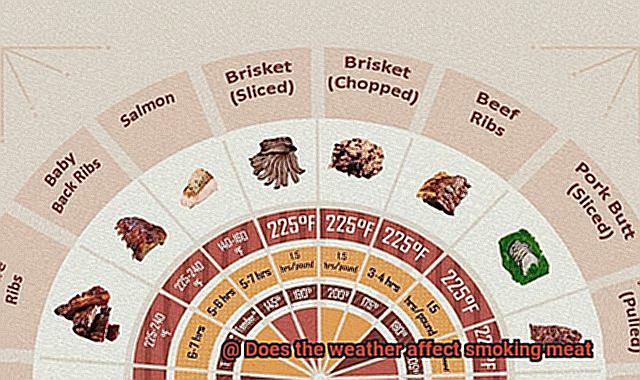
Temperature and Smoking Meat
Smoking meat is no ordinary cooking method; it’s an art form that requires a delicate dance between temperature and weather conditions. In this tantalizing exploration, we will unravel the secrets behind these factors and discover how they can transform your meat into mouthwatering masterpieces.
The Ideal Smoking Temperature:
Picture this: a slow and steady dance of heat, where temperatures range from a tantalizing 225°F to 250°F (107°C to 121°C). This sweet spot allows the meat to cook gently, ensuring that the flavors seep deep within while keeping every succulent bite tender and juicy.
The Impact of High Temperatures:
Beware the fiery inferno that spells doom for your smoking adventure. A blazing hot grill can spell disaster, leading to tough textures and a diminished smoky essence. Keep a watchful eye on your smoker’s temperature dial, adjusting it with precision like a maestro conducting a symphony.
The Challenge of Cold Weather:
Winter’s icy grip can send shivers down your spine and wreak havoc on your smoking endeavors. But fear not, for there are ways to combat the chill. Wrap your smoker in layers of insulation, shielding it from the bitter cold. Utilize windbreaks to tame the gusts that threaten to steal away precious heat. And remember, preheating is not merely a suggestion; it’s a necessity for achieving stable temperatures amidst winter’s frosty embrace.
Wind’s Role in Temperature Fluctuations:
As nature’s mischievous accomplice, wind can cause chaos within the confines of your smoker. It sneaks through every crevice, stealing away warmth and leaving temperature fluctuations in its wake. To outsmart this wily adversary, choose a sheltered spot for your smoker or erect windbreaks that shield it from the wind’s relentless onslaught.
Battling the Heat on Hot Days:
Ah, the scorching days of summer, when the sun beats down with unrelenting force. Your smoker quivers under the oppressive heat, struggling to maintain composure. Fear not, brave grillmaster. With a few adjustments and a touch of ingenuity, you can tame the fiery beast. Fine-tune your vents, allowing just the right amount of airflow to keep temperatures in check. Add insulation for an extra layer of protection against the blistering heat. Let nothing stand between you and your perfectly smoked creation.
Monitoring Weather Conditions:
Mother Nature is a fickle mistress, ever-changing and unpredictable. To conquer her whims, keep a watchful eye on weather conditions as you embark on your smoking adventure. Adaptability is key; be ready to make the necessary adjustments to maintain that sweet spot of temperature perfection.
Humidity and Smoking Meat
In this guide, we will unlock the secrets of humidity management and show you how to take your smoked meat to new heights of deliciousness.
The Role of Humidity:
Humidity is like the conductor of an orchestra, shaping the flavor and texture of your smoked meat. High humidity can dampen smoke formation, resulting in a milder taste. Conversely, low humidity can quickly dry out your meat, leaving it tough and unappetizing. Striking the perfect balance is the key to a successful smoke.
Managing Humidity:
- Water Pans: These trusty companions sit inside your smoker, providing a moisture source that helps regulate humidity levels. They not only prevent your meat from drying out but also ensure it stays tender and juicy.
- Spritzing: Give your meat some love by spritzing it with water, fruit juices, or flavorful liquids. This not only keeps it moist but also adds an extra punch of taste. Find that sweet spot where your meat is moist but not excessively wet.
- Smoker Type Matters: Different smokers have varying airflow capabilities. Offset smokers may require more attention in maintaining humidity levels compared to vertical or electric smokers. Adjust ventilation and water pan placement accordingly.
- Weather Considerations: Mother Nature can throw curveballs at our grilling plans. If you’re smoking outdoors during rainy weather or high humidity, take precautions to shield your smoker from rain or consider alternative methods like smoking indoors or under cover.
Wind and Smoking Meat
We’ve covered the importance of humidity management in our previous section, but today we’re turning our attention to another elemental force that can impact the art of smoking meat: the wind. So grab your aprons and let’s dive right in.
Wind, with its unpredictable nature, can pose challenges when it comes to smoking meat. But fear not. With a few tips and tricks up your sleeve, you can overcome any gusts that come your way.
Temperature Control:
Consistency is key when it comes to achieving that perfect smoky flavor. Wind can be a pesky little devil, causing temperature fluctuations that make it harder to maintain that sweet spot. To combat this, consider using windbreaks as your secret weapon. Constructed with materials like plywood or strategically placed furniture, windbreaks create a barrier that shields your smoker from unruly gusts. Say goodbye to wild temperature swings.
Airflow Management:
Proper circulation of smoke inside the smoker ensures an even distribution of flavor and an evenly cooked final product. However, when the wind decides to play tricks on you, it can disrupt this precious airflow. Once again, windbreaks come to the rescue. By creating a sheltered space for your smoker, you’re preventing those strong winds from interfering with the smoke’s journey. Your taste buds will thank you later.
Strategic Placement:
Positioning your smoker against a wall or in a sheltered corner of your outdoor space provides added protection from blustery winds. Think of it as finding a cozy nook for your meat to soak up all that beautiful smoky goodness undisturbed.
Insulated Smokers:
Investing in a well-insulated smoker can help combat the effects of wind. These smokers are designed to retain heat better and are less susceptible to temperature fluctuations caused by external factors like wind. So, if you’re serious about your smoking game, consider upgrading to an insulated smoker.
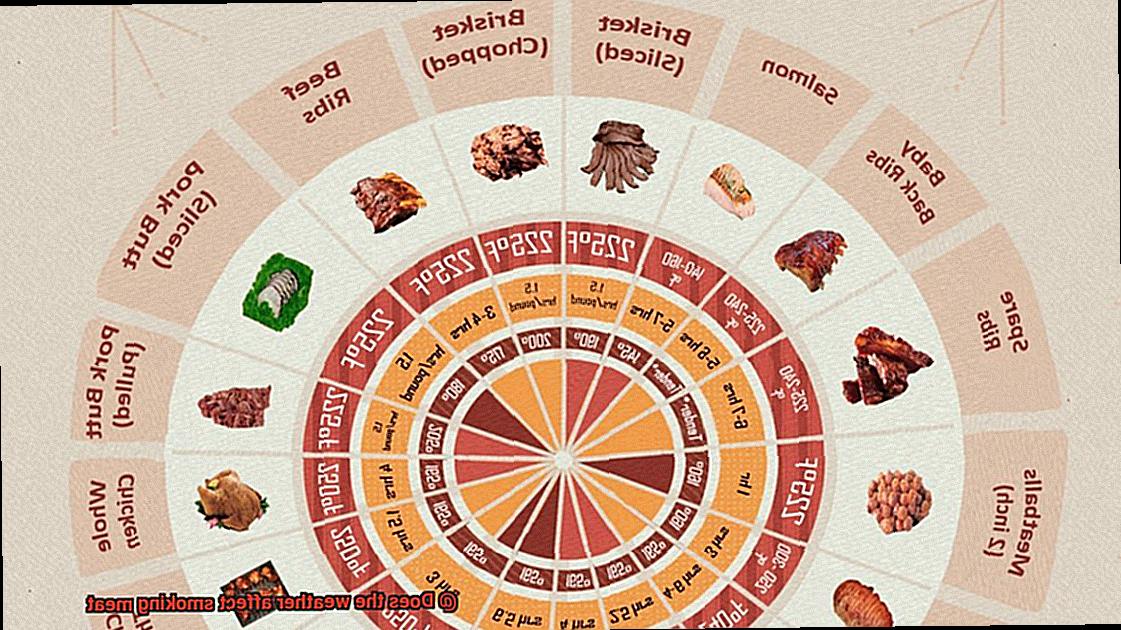
Vents as Temperature Control:
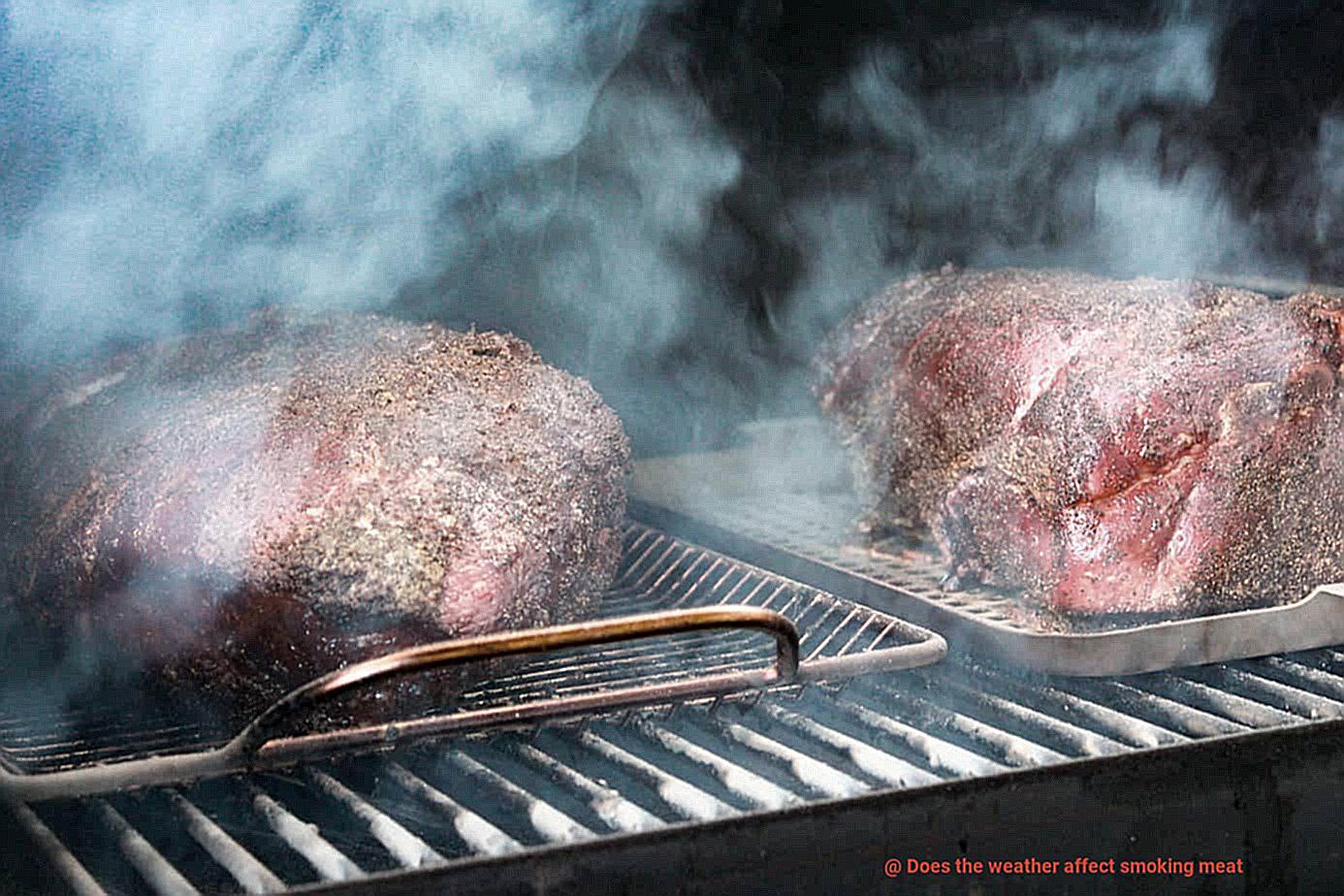
Monitoring and adjusting the vents on your smoker can help regulate airflow and maintain a steady temperature inside, even when the wind is acting up. It’s like having your own personal temperature control system – pretty cool, right?
Patience is Key:
One last thing to keep in mind when battling windy conditions: patience. Wind can slow down the cooking process, so don’t rush it. Take your time, monitor those internal meat temperatures regularly, and adjust your cooking times accordingly. Your patience will be rewarded with smoky perfection.
So there you have it, my fellow grill masters. Wind may try to throw a wrench in your smoking game, but armed with these tips and tricks, you’ll be able to overcome any gusts that come your way. Embrace the elements, adapt, and let your smoked meats shine.
Fuel Needed for Smoking in Different Weather Conditions
Smoking meat is an art, and like any artist, you need the right tools and materials to create your masterpiece. When it comes to smoking in different weather conditions, the fuel you choose plays a crucial role in achieving that perfect smoky flavor. So, let’s dive in and explore what fuel is needed for smoking in various weather scenarios.
Cold Weather:
Imagine a winter wonderland, with snowflakes falling gently around you. In these chilly conditions, your smoker will take longer to warm up and maintain a steady temperature. To keep the fire burning and maintain that ideal heat level, you’ll need more fuel. The cold air is unforgiving, and your smoker needs that extra boost to combat the frosty temperatures.
Hot Weather:
Now, let’s shift gears and bask in the warmth of the sun. In hotter weather, your smoker behaves differently. It heats up faster and retains that heat like a champ. The good news is that you’ll require less fuel to reach and maintain the desired temperature. However, be cautious in scorching temperatures as there is a risk of overheating. Keep a close eye on that thermometer and adjust your fuel intake accordingly to avoid turning your precious meat into charcoal.
Humidity:
Ah, the sneaky little devil called humidity. Did you know it can affect your fuel consumption too? In humid conditions, moisture in the air makes it harder for the fire to burn efficiently. You may find yourself adding more fuel than usual to keep that flame alive and achieve that sweet spot temperature. Be prepared for this challenge when smoking on humid days.
Impact of Different Types of Wood on Weather Conditions
Calling all grill masters. Are you ready to elevate your smoked meat game? Get ready to explore how different types of wood and weather conditions can ignite a flavor explosion in your backyard barbecues. Grab your aprons and tongs because we’re diving into the captivating world of smoked meat.
Wood Choice: A Flavorful Journey
Not all woods are created equal when it comes to smoking meat. Each wood brings its own unique flavor profile to the table. Mesquite adds a bold, smoky punch, while fruitwoods like apple or cherry offer a hint of sweetness. Choose your wood wisely based on the flavor you desire for your meat masterpiece.
Moisture Content: Watch Out for Damp Wood
Imagine this: you’ve got your smoker fired up, but the wood you’re using is wet. Uh-oh. Wet wood means more smoke and a longer cooking time. In humid or rainy weather, finding dry wood can be a challenge. Remember, dry wood equals a faster burn and more control over your cooking time.
Density Matters: Hardwood vs. Softwood
When it comes to smoking meat, density matters. Dense hardwoods like oak or hickory burn slowly, providing a steady heat source ideal for cooler weather conditions. They maintain that perfect temperature even when it’s chilly outside.
On the other hand, softer woods like fruitwoods burn faster and are better suited for hotter weather or when you want a higher cooking temperature.
Weather Conditions: Temperature Tango
Weather plays a vital role in smoking meat. Colder temperatures mean longer cooking times and potential temperature fluctuations. Hotter weather can speed things up, but be careful not to overcook or dry out your meat. Aim for a sweet spot between 225°F and 275°F for that perfect smoky goodness.
Humidity: The Moisture Maze
Humidity levels can make or break your smoked meat. High humidity can slow down evaporation, resulting in moister meat. However, too much humidity can affect the smoke ring and bark formation. Finding the right balance is key to achieving that mouthwatering texture and taste.
Wind: The Sneaky Culprit
Don’t let the wind blow away your barbecue dreams. Strong gusts can disrupt the airflow inside your smoker, leading to uneven cooking or inconsistent smoke distribution. Position your smoker in a sheltered area or use windbreaks to maintain that perfect smoking environment.
Food Safety Considerations When Smoking in Different Weather Conditions
In this blog post, we will explore the key considerations for ensuring food safety when smoking in different weather conditions. So, grab your apron and let’s dive in.
Temperature Control:
Maintaining a consistent temperature is paramount when smoking meat. In hot weather, generating heat is a breeze, but in cold weather, it poses a challenge. Strong winds and low temperatures can affect your smoker’s performance. To guarantee proper cooking and eliminate harmful bacteria, invest in a reliable meat thermometer. This tool allows you to closely monitor the internal temperature of the meat, especially in cold weather when the cooking process may slow down.
Cross-Contamination:
Cross-contamination is always a concern, regardless of the weather. During hot weather, bacteria multiply rapidly on raw meat if left outdoors for too long. Properly store and handle raw meat to prevent contamination. In cold weather, although bacterial growth slows down, the risk of cross-contamination still exists. Keep cooked and raw meats separate and thoroughly clean utensils between uses.
Moisture Management:
Rainy or humid conditions can lead to moisture buildup inside the smoker, creating an ideal environment for bacteria growth. Ensure your smoker is properly sealed and protected from rain or excessive humidity. Regularly check for moisture buildup and take appropriate measures to remove it, such as using a towel or wiping down the interior.
Cooking Times:
Different weather conditions can impact cooking times. In cold weather, it may take longer for the meat to reach the desired internal temperature, while hot weather may expedite the process. To ensure food safety, follow recommended cooking times and temperature guidelines.
tBGYm4-7h0o” >
Conclusion
The conclusion is clear: the weather does indeed affect smoking meat.
Whether it’s a scorching summer day or a chilly winter evening, the elements play a significant role in the smoking process. In hot weather, the heat can cause the meat to cook too quickly, resulting in dry and tough textures.
On the other hand, smoking meat in cold weather requires more patience and attention as low temperatures can lengthen cooking times. Additionally, rain or high humidity can impact the smoke absorption process, leading to less flavorful results.
Therefore, it’s crucial for smokers to take into account the weather conditions when preparing their meats to ensure optimal taste and texture.
You may also like:



